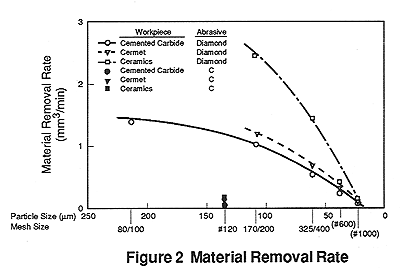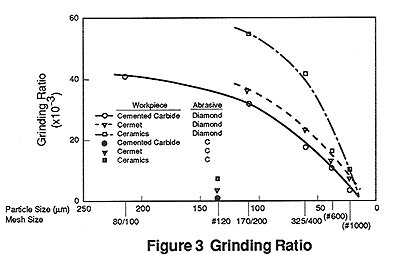A. Material Removal Rate
The material removal rate with diamond brushes is remarkably higher than the brushes of silicon carbide (C) abrasives for all the materials in test.
The material removal rate increases as the diamond particle size in brush fibers increases in the test of all the materials.
 The diamond brushes show the
highest material removal rate for ceramics and show the lowest material
removal rate for tungsten carbide. It seems that this difference of removal
rate is caused by the difference in the material characteristics such
as feedstock size or bonding system and its strength among the particles.
The diamond brushes show the
highest material removal rate for ceramics and show the lowest material
removal rate for tungsten carbide. It seems that this difference of removal
rate is caused by the difference in the material characteristics such
as feedstock size or bonding system and its strength among the particles.
B. Grinding Ratio
The diamond brushes show again a remarkably higher grinding ratio than the C abrasives which can give only a remarkably smaller volume of material removal.
Grinding ratio of the diamond brushes increases as the particle size increases for all the materials in test.
 The diamond brushes show the
highest grinding ratio in the grinding of ceramics and show the lowest
grinding ratio in the grinding of tungsten carbide, which well corresponds
to the results of material removal rate described in above A.
The diamond brushes show the
highest grinding ratio in the grinding of ceramics and show the lowest
grinding ratio in the grinding of tungsten carbide, which well corresponds
to the results of material removal rate described in above A.
C. Workpiece Surface Finish
Workpiece surface finish treated with the diamond brushes is rougher than that with the C abrasives brushes. It is due to the significant sharpness of diamond abrasive over C abrasive. The surface finish with C abrasive including #120 is equivalent to that with diamond micron power of #600 in an approximate mesh size.
 Workpiece surface finish treated
with diamond brushes becomes smoother as the particle size decreases for
all the materials in test.
Workpiece surface finish treated
with diamond brushes becomes smoother as the particle size decreases for
all the materials in test.
D. Tangential Grinding Force
Diamond brushes generate a slightly lower tangential grinding force compared with the C abrasive brushes. This shall be one indication of C abrasive dullness.
 In general, the tangential grinding
force decreases for all the materials in test, as the particle size of
diamond brushes decreases.
In general, the tangential grinding
force decreases for all the materials in test, as the particle size of
diamond brushes decreases.
E. Workpiece Temperature Increase in Grinding
Diamond brushes generate a lower temperature increase in treated materials, compared with the C abrasive brushes. This is related to the shape cutting edges remarkably high thermal conductivity of diamond abrasives.
 Brushes of 325/400 mesh size
and #600 show the lowest workpiece temperature in case of the diamond
brushes.
Brushes of 325/400 mesh size
and #600 show the lowest workpiece temperature in case of the diamond
brushes.